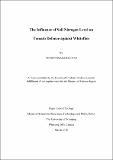The Influence of Soil Nitrogen Level on Tomato Defence against Whiteflies

View Open
Metadata
Afficher la notice complèteAuthor
Ramachandran, Sreedevi
Date
2018-03Citation
Ramachandran, Sreedevi. The Influence of Soil Nitrogen Level on Tomato Defence against Whiteflies; a thesis submitted to the Faculty of Graduate Studies in partial fulfillment of the requirements for the Masters of Science degree, Department of Biology, Master of Science in Bioscience, Technology and Public Policy, The University of Winnipeg. Winnipeg, Manitoba, Canada: University of Winnipeg, 2018.
Abstract
Whiteflies are one of the leading causes of tomato yield loss worldwide. Phloem feeders, including whiteflies, prefer foliage with high nitrogen (N) content because organic N is a limiting factor for herbivores. Since soil N is commonly insufficient for adequate crop growth, farmers supplement soils with N-containing fertilizers. While an adequate supply of N and other nutrients is necessary for growth and fruit production, by increasing the N content of the plant tissues, soil N supplementation could cause the plants to be less resistant to whiteflies. Therefore, there must be a level of fertilizer addition beyond which the losses in fruit production caused by greater attraction and feeding of pests exceed the gains brought about by N availability. In this study, we grew four commercial tomato varieties under three levels of soil N fertilization and infested half of these plants with whiteflies after eight weeks of growth. After 20 weeks of growth, we compared the yield and resource allocation in whitefly infected and uninfected plants to find whether soil N supplementation results in greater susceptibility of tomato plants to whitefly infestation and if so, to what extent; and to find whether some varieties of tomato are more resistant or tolerant to whiteflies. We observed no significant reduction in fruit production whereas the resistance increased significantly when the amount of N addition was reduced to half of the commercially recommended amount. The varieties differed in resistance and tolerance to whiteflies and a tradeoff between resistance and tolerance was also noted. Afamia was the most resistant and the least tolerant variety, while Conquistador was the least resistant and the most tolerant variety. Enhancing the natural defences of tomato varieties by lowering fertilizer application could improve the farmers’ economic benefits, thereby balancing the losses in yield due to lower fertilizer application. Decreased use of fertilizers and pesticides can also reduce social and environmental costs of largescale use of agricultural chemicals.
